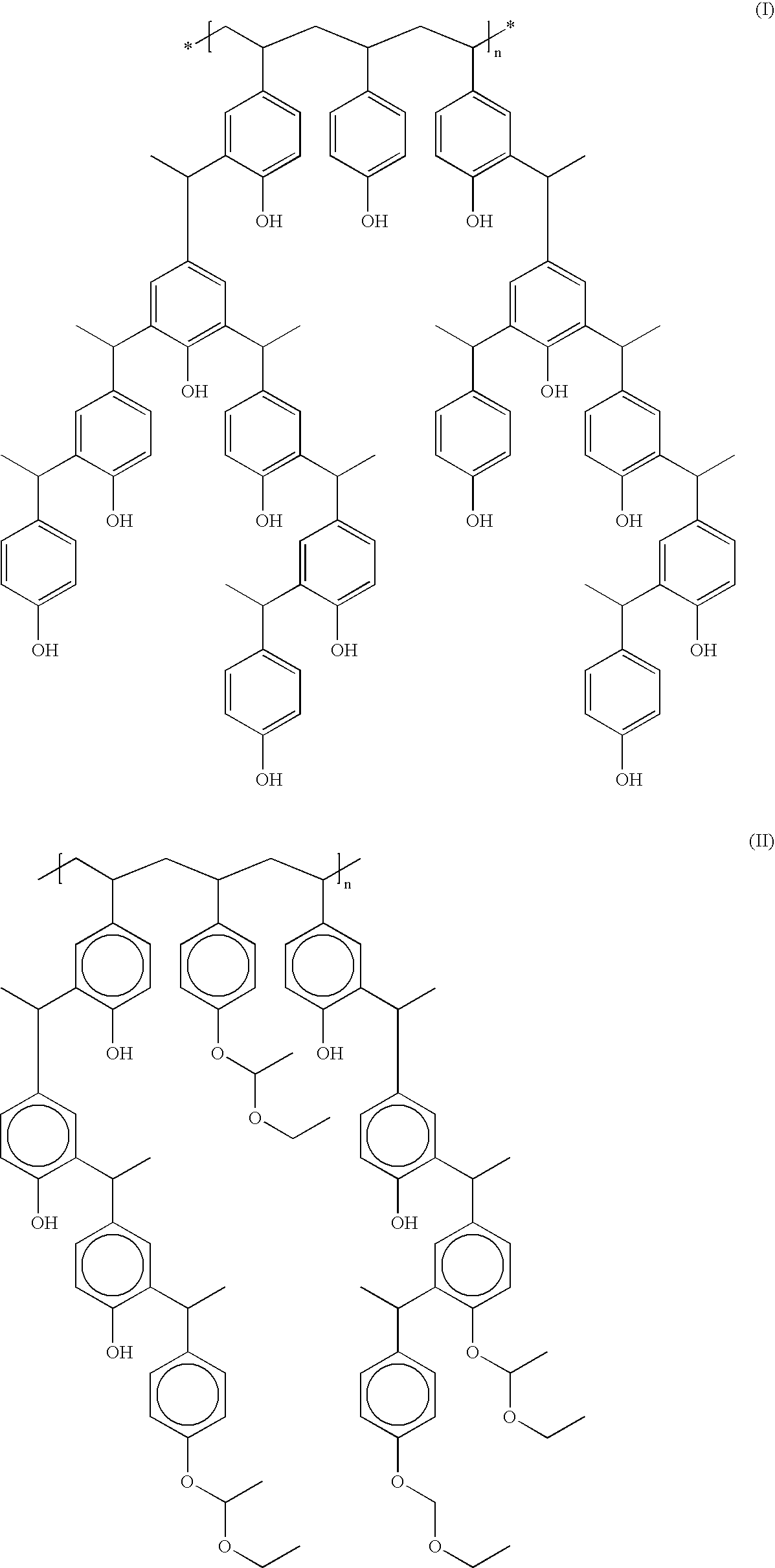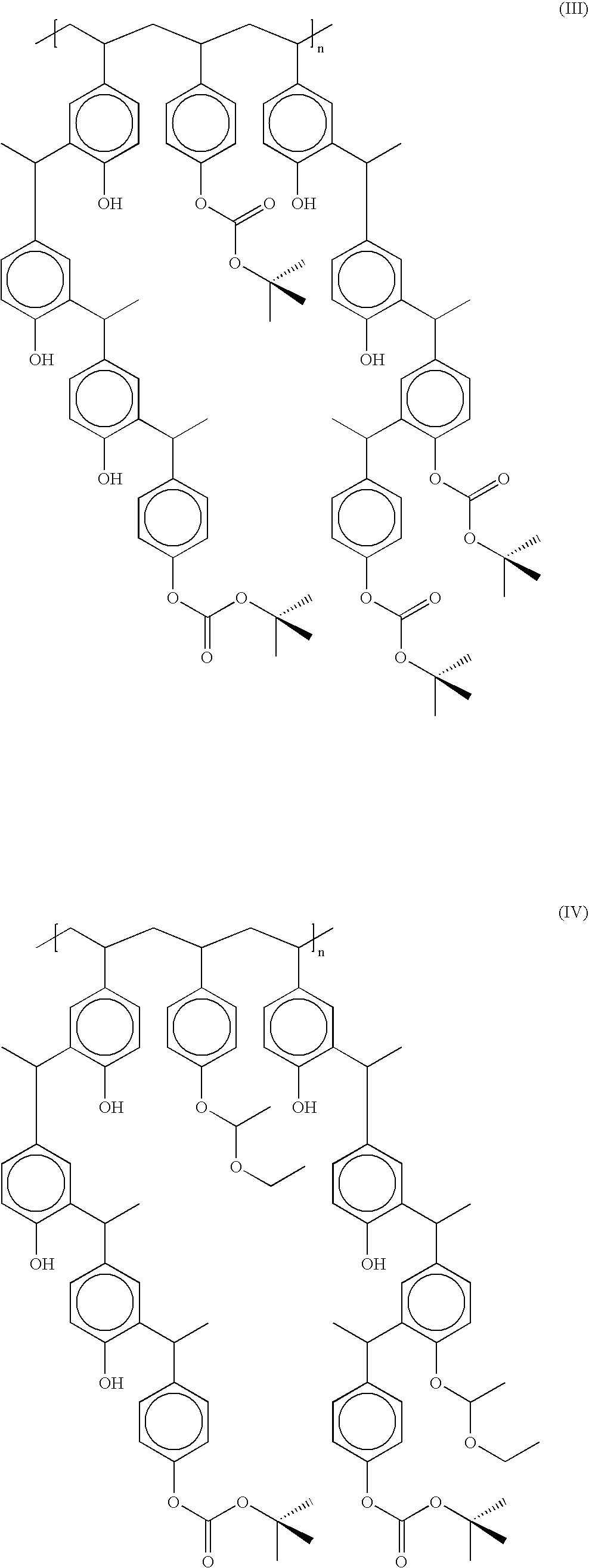Derivatized polyhydroxystyrenes (DPHS) with a novolak type structure and blocked DPHS (BDPHS) and processes for preparing the same
a technology of derivatized polyhydroxystyrene and dphs, which is applied in the direction of auxillary/base layers of photosensitive materials, instruments, photosensitive materials, etc., can solve the problems of not being disclosed and commercially feasible, and achieve the effect of low polydispersity
- Summary
- Abstract
- Description
- Claims
- Application Information
AI Technical Summary
Benefits of technology
Problems solved by technology
Method used
Image
Examples
example 1
[0071] 4-Hydroxyphenylmethylcarbinol Methyl Ether (HPMEE) Synthesis.
[0072] To 15 gms of methanolic solution containing 22.2% 4-hydroxyphenylmethylcarbinol (HPMC) was added 0.45 gms of Amberlyst A-15 acid ion exchange resin. This mixture was allowed to stand for 72 hours at room temperature. HPLC analysis indicates that the resulting solution contains only 0.21% HPMC (99% conversion) with the remainder being HPME. This material thus produced is suitable for use as a raw material in the preparation of the DPHS polymer.
[0073] Polymerization of 4-Hydroxyphenylmethylcarbinol Methyl Ether (HPME), Production of DPHS Polymer in Methanol Solution.
[0074] To a 500 ml flask fitted with a nitrogen inlet, mixer, temperature indicator and controller, and reflux condenser was added 226 gms of methanol solution containing 30.4% HPME (68.7 gms HPME) raw material. Using solvent distillation 131 gins of methanol was removed rendering a solution containing 72.3% HPME in methanol.
[0075] The resulting...
example 3
50% Acetal Blocked DPHS
[0080] To a four neck three litter round bottom flask equipped with mechanical stirrer, nitrogen purge inlet and outlet, distillation column, condenser and a receiver, 245 g (2.04 moles as phenol OH equivalents) of DPHS and PGMEA, 617 g were charged. The mixture was stirred under nitrogen at 25° C. to a homogeneity and then PGMEA was distilled at 50° C. at 10 torr to remove residual water to less than 300 ppm. The solution was cooled to 5° C. and a solution of trifluoroacetic acid, 0.5 g in PGMEA 3 g was added under nitrogen purge and stirring. To the solution, ethylvinylether, 73.6 g, 1.02 mole, 50 mole equivalent to phenolic OH on DPHS was added dropwise at 5° C. under nitrogen with stirring. The mixture was stirred at 5° C. for 3 hr. and at 25° C. for 10 hr.
[0081] The solution was then applied to a column (25 mm diameter and 250 mm length) containing IRA96 in PGMEA at 8 ml / min. to remove the catalyst. The blocking level was determined to be 51 mole % by C...
example 4
40% Acetal Blocked DPHS
[0082] To a four neck three liter round bottom flask equipped with mechanical stirrer, nitrogen purge inlet and outlet, distillation column, condenser and a receiver, 258 g (2.15 moles as phenol OH equivalents) of DPHS and PGMEA, 628 g were charged. The mixture was stirred under nitrogen at 25° C. to a homogeneity and then PGMEA was distilled at 50° C. at 10 torr to remove residual water to less than 300 ppm. The solution was cooled to 5° C. and a solution of trifluoroacetic acid, 0.5 g in PGMEA 3 g was added under nitrogen purge and stirring. To the solution, ethylvinylether, 62 g, 0.86 mole, 40 mole equivalent to phenolic OH on DPHS was added dropwise at 5° C. under nitrogen with stirring. The mixture was stirred at 5° C. for 3 hr. and at 25° C. for 10 hr.
[0083] The solution was then applied to a column (25 mm diameter and 250 mm length) containing ERA96 in PGMEA at 8 ml / min. to remove the catalyst. The blocking level was determined to be 43 mole % by C13 ...
PUM
| Property | Measurement | Unit |
|---|---|---|
| polydispersity | aaaaa | aaaaa |
| pressure | aaaaa | aaaaa |
| temperature | aaaaa | aaaaa |
Abstract
Description
Claims
Application Information
 Login to View More
Login to View More - R&D
- Intellectual Property
- Life Sciences
- Materials
- Tech Scout
- Unparalleled Data Quality
- Higher Quality Content
- 60% Fewer Hallucinations
Browse by: Latest US Patents, China's latest patents, Technical Efficacy Thesaurus, Application Domain, Technology Topic, Popular Technical Reports.
© 2025 PatSnap. All rights reserved.Legal|Privacy policy|Modern Slavery Act Transparency Statement|Sitemap|About US| Contact US: help@patsnap.com



